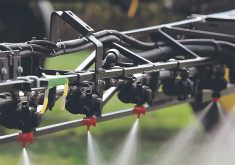Canola growers facing late season insect pests like diamondback moth, bertha armyworm and cabbage seedpod weevil have a new control option.
In the past, Matador had a 50-day preharvest interval, but as a result of new data from Syngenta, that time frame will soon be reduced to seven days.
“This marks a significant and welcome change for canola growers looking for late season pest control,” said David Hoar, pulse crop manager with Syngenta, the makers of Matador.
“Growers have told us they like this product for its faster knockdown and low volumes.”
Read Also

University of Manitoba hires potato researcher
A new research chair position at the University of Manitoba will tackle sustainability in the potato industry.
Late season canola pests can cause significant crop damage and growers have had few control options.
“Matador is an advanced pyrethroid that has both contact and residual activity on target pests,” said Hoar.
Direct contact with Matador will control target pests and spray residue on leaves provides residual control.
“For many insects, this residual activity helps slow significant reinfestation for 10 days or longer, depending on the insect and weather conditions.”
Because Matador bonds to the waxy top layers of plant tissue, it resists wash off by rain. The product can be applied by air or ground.
The seven-day preharvest interval for Matador has been accepted for registration, pending final labelling, and applies to mustard, flax and sunflowers, along with canola.














